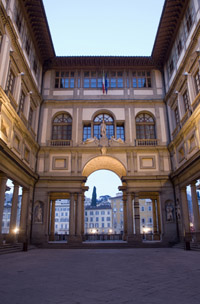Uffizi Gallery in Florence, Italy
 The Uffizi Gallery covers an area of about 8,000 square meters and contains one of the most important collections of art of all times, including classical sculpture and paintings on canvas and wood by 13th to 18th century Italian and foreign schools. The Gallery of the Uffizi was also the first museum ever to be opened to the public: in fact the Grand Duke granted permission to visit it on request from the year 1591. Its four centuries of history make the Uffizi Gallery the oldest museum in the world.
The Uffizi Gallery covers an area of about 8,000 square meters and contains one of the most important collections of art of all times, including classical sculpture and paintings on canvas and wood by 13th to 18th century Italian and foreign schools. The Gallery of the Uffizi was also the first museum ever to be opened to the public: in fact the Grand Duke granted permission to visit it on request from the year 1591. Its four centuries of history make the Uffizi Gallery the oldest museum in the world.
Cosimo I de' Medici decided to build the Palace, whose construction was started by Giorgio Vasari in 1560 and later completed by Buontalenti, who designed the famous Tribune, to house the administrative offices (or "uffizi") of the Government because Palazzo Vecchio, which also overlooks Piazza della Signoria, had become too small to hold them all. However it was his son Francesco I who was responsible for starting to turn the palace into a museum in 1581, when he closed the second floor Gallery with huge windows and arranged part of the grand-ducal collection of classical statues, medals, jewellery, weapons, paintings and scientific instruments here.
The Medici were untiring collectors and were forever adding to the Gallery: some of the most important elements to be added to the collection came from the inheritance left by Ferdinando II 's mother, Vittoria della Rovere (1631), together with the many acquisitions made by Cardinal Leopoldo de' Medici (1617-1675), which were to create the basis of the Gallery of Prints and Drawings (on the first floor of the Uffizi, on the site of the old Court Theatre built by Bernardo Buontalenti) and the collection of Self-portraits, exhibited today in the Vasari Corridor linking the Uffizi to the royal palace of Pitti.
When Gian Gastone, the last Medici Grand Duke, died, his sister Anna Maria Ludovica managed to prevent the artistic patrimony from being scattered with the famous "Family Pact" (1737, and reconfirmed in her will of 1743), which, instead of bequeathing everything to the successors of the House of Hapsburg-Lorraines, left the collections to the city of Florence itself "to be an ornament to the Government, useful to the public and to attract the curiosity of foreigners". This document proved to be vitally important when the time came to retrieve the art works that had been removed and taken to Paris in Napoleonic times.
Altered and rearranged several times over the centuries, according to the cultural tastes of the various periods, the exhibition rooms are now composed of over 45 rooms containing about 1,700 paintings, 300 sculptures, 46 tapestries and 14 pieces of furniture and/or ceramics. In actual fact the Uffizi owns about 4,800 works, the remainder of which are either in storage or on loan to other museums. The Uffizi gallery houses magnificent works by Raphael, Titian, and Botticelli.